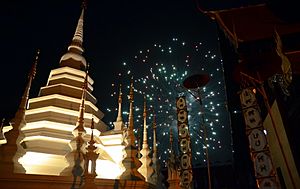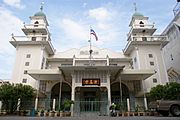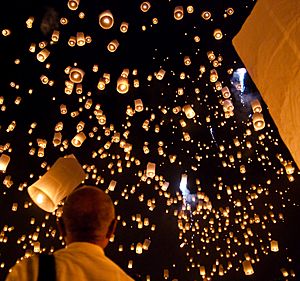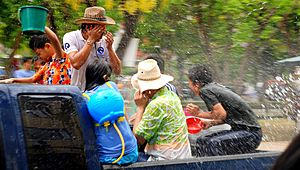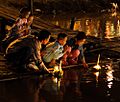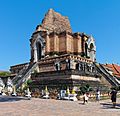Chiang Mai facts for kids
Quick facts for kids
Chiang Mai
|
|
|---|---|
| เชียงใหม่ | |
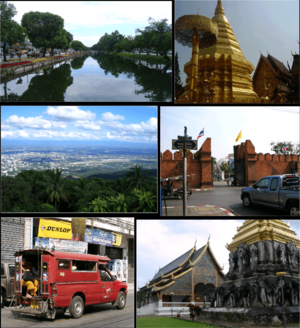
Chiang Mai
|
|

Location of in Chiang Mai Province
|
|
| Country | |
| Province | Chiang Mai Province |
| Government | |
| • Type | City municipality |
| Area | |
| • City | 40.216 km2 (15.527 sq mi) |
| • Metro | 2,905 km2 (1,122 sq mi) |
| Population
(2008)
|
|
| • City | 148,477 |
| • Density | 3,687/km2 (9,550/sq mi) |
| • Metro | 960,906 |
| • Metro density | 315.42/km2 (816.9/sq mi) |
| Time zone | UTC+7 (Thailand) |
| Airport | IATA: CNX – ICAO: VTCC |
Chiang Mai sometimes written as "Chiengmai" or "Chiangmai", is the largest and most culturally significant city in northern Thailand. It is the capital of Chiang Mai Province. It is located 700 km (435 mi) north of Bangkok, among the highest mountains in the country. The city is along the Ping River, a major tributary of the Chao Phraya River. Chiang Mai means "new city" and was so-named because it was the new capital, founded in 1296, succeeding Chiang Rai (founded 1262) in the capital of the Lanna kingdom.
In recent years, Chiang Mai has become an increasingly modern city and has been attracting over 5 million visitors each year, of which between 1.4 million and 2 million are foreign tourists. Chiang Mai is one of three Thai cities contending to host the World Expo 2020. It has also recently positioned itself to become a Creative City and is considering to apply for Creative City Status with UNESCO. Chiang Mai is the only tourist destination in Thailand to have made it in to the 2012 list of "25 Best Destinations in the World" of the popular travel website TripAdvisor, standing in place 24.
Chiang Mai's historic importance is derived from its close proximity to the Ping river and major trading routes.
While officially the city (thesaban nakhon) of Chiang Mai only covers most parts of the Mueang Chiang Mai district with a population of 160,000, the urban sprawl of the city now extends into several neighboring districts. This Chiang Mai Metropolitan Area has a population of nearly one million people, more than half the total of Chiang Mai Province.
The city is subdivided into four wards (khwaeng): Nakhon Ping, Srivijaya, Mengrai, and Kawila. The first three are on the west bank of the Ping River, and Kawila is located on the east bank. Nakhon Ping district comprises the north side of the city. Srivijaya, Mengrai, and Kawila consist of the west, south, and east respectively. The city center—within the city walls—is mostly within Srivijaya ward.
Religious sites
Chiang Mai has over 300 Buddhist temples (called "wat" in Thai). These include:
- Wat Phrathat Doi Suthep, the city's most famous temple, stands on Doi Suthep, a hill to the north-west of the city. This temple dates from 1383.
- Wat Chiang Man, the oldest temple in Chiang Mai, dates from the 13th century. King Mengrai lived here during the construction of the city. This temple houses two important and venerated Buddha figures, the marble Phra Sila and the crystal Phra Satang Man.
- Wat Phra Singh is located within the city walls, dates from 1345 and offers an example of classic northern Thai style architecture. It houses the Phra Singh Buddha, a highly venerated figure brought here many years ago from Chiang Rai.
- Wat Chedi Luang was founded in 1401 and is dominated by a large Lanna style chedi which took many years to finish. An earthquake damaged the chedi in the 16th century and only two-thirds of it remains.
- Wat Chet Yot is located on the outskirts of the city. Built in 1455, the temple hosted the Eighth World Buddhist Council in 1977.
- Wiang Kum Kam is at the site of an old city on the southern outskirts of Chiang Mai. King Mengrai lived there for ten years before the founding of Chiang Mai. The site includes many ruined temples.
- Wat Umong is a forest and cave wat in the foothills in the west of the city, near Chiang Mai University. Wat U-Mong is known for its fasting Buddha, representing the Buddha at the end of his long and fruitless fasting period before he gained enlightenment.
- Wat RamPoeng (Tapotaram), near Wat U-Mong, is known for its meditation center (Northern Insight Meditation Center). The temple teaches the traditional vipassana technique and students stay from 10 days to more than a month as they try to meditate at least 10 hours a day. Wat RamPoeng houses the largest collection of Tipitaka, the complete Theravada canon, in several Northern dialects.
- Wat Suan Dok is a 14th century temple located just west of the old city-wall. It was built by the king for a revered monk visiting from Sukhothai for the rains retreat. The temple is also the site of Mahachulalongkorn Rajavidyalaya Buddhist University, where monks pursue their studies.
- "First Church", Chiang Mai, was founded in 1868 by the Laos Mission of the Rev. Daniel and Mrs. Sophia McGilvary. Chiang Mai has about 20 Christian churches Chiang Mai is the seat of the Roman Catholic Diocese of Chiang Mai.
Culture
Festivals
Chiang Mai hosts many Thai festivals, including:
- Loi Krathong (known locally as Yi Peng): Held on the full moon of the 12th month in the traditional Thai lunar calendar, being the full moon of the 2nd month of the old Lanna calendar. In the western calendar this usually falls in November. Every year thousands of people assemble floating banana-leaf containers (krathong) decorated with flowers and candles onto the waterways of the city to worship the Goddess of Water. Lanna-style sky lanterns (khom fai or kom loi), which are hot-air balloons made of paper, are launched into the air. The sky lanterns are believed to help rid the locals of troubles and are also taken to decorate houses and streets.
- Songkran: Held in mid-April to celebrate the traditional Thai new year. Chiang Mai has become one of the most popular locations to visit for this festival. A variety of religious and fun-related activities (notably the good-natured city-wide water-fight) take place each year, along with parades and a Miss Songkran beauty competition.
- Chiang Mai Flower Festival: A three-day festival held during the first weekend in February each year, this event occurs when Chiang Mai's temperate and tropical flowers are in full bloom.
- Tam Bun Khan Dok, the Inthakin (City Pillar) Festival, starts on the day of the waning moon of the six lunar month and lasts 6–8 days.
Museums
- Chiang Mai City Arts and Cultural Center.
- Chiang Mai National Museum highlights the history of the region and the Kingdom of Lanna.
- Tribal Museum showcases the history of the local mountain tribes.
- Mint Bureau of Chiangmai or Sala Thanarak, Treasury Department, Ministry of Finance, Rajdamnern Road (one block from AUA) has an old coin museum open to the public during business hours. The Lanna Kingdom used leaf (or line) money made of brass and silver bubbles, also called "pig-mouth" money. Nobody has been able to duplicate the technique of making pig-mouth money, and because the silver is very thin and breakable, good pieces are now very rare.
Dining
- Khantoke dinner is an old Lanna Thai tradition in Chiang Mai. It is an elaborate dinner or lunch which is offered by a host to guests at various ceremonies or parties, e.g. at weddings, housewarmings, celebrations, novice ordinations, or funerals. It can also be held for temple celebrations such as celebrations for specific buildings in a Thai temple and at Buddhist festivals such as Khao Pansa, Og Pansa, Loy Krathong, and Thai New Year (Songkran).
Nature
- The nearby national parks include Doi Inthanon National Park, which includes Doi Inthanon, the highest mountain in Thailand; Doi Pui Suthep; and Obkhan.
- Doi Pui Suthep National Park is just outside town. From all over Chiang Mai you can see the Wat Doi Suthep Buddhist temple looking down on the town from Doi Suthep mountain.
- Elephant Nature Park: Approximately 60 km (37 mi) north of the city or about one hour drive, the Elephant Nature Park is home to approximately 30 rescued elephants.
Images for kids
-
People floating krathong rafts during the Loi Krathong festival in Chiang Mai
-
Street food, Sunday Evening Market
See also
 In Spanish: Chiang Mai para niños
In Spanish: Chiang Mai para niños


